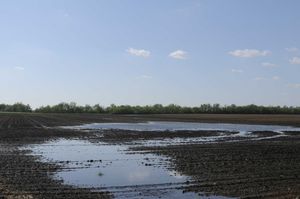Corn Final Planting Date Nears, Prevented Planting Acres May Increase
 As Mid-South corn farmers wait for rains to subside and fields to dry, they face final insurable planting dates and need to begin considering insurance options, including prevented planting acres.
As Mid-South corn farmers wait for rains to subside and fields to dry, they face final insurable planting dates and need to begin considering insurance options, including prevented planting acres.
For Clay, Craighead, Greene, Independence, Jackson, Lawrence, Mississippi, Poinsett, and Randolph, counties in Arkansas, final planting date for corn is May 1. The late planting period ends May 16. For all other counties in Arkansas, April 25 is the final planting date and the late planting period ends on May 10.
In southeast Missouri, Butler, Dunklin, Mississippi, New Madrid, Pemiscot and Stoddard counties, May 10 is the final planting date and the late planting period ends May 30. For Bollinger, Cape, and Perry counties, May 25 is the final planting date and the late planting period ends on June 14.
According to the United States Department of Agriculture’s Risk Management Agency, the final planting date for corn in Louisiana was April 15. The late planting period ends on April 30. “Some corn farmers in our state continue being delayed from planting, but many were lucky enough to get into fields. Our state is 60% planted currently,” says Dan Fromme, state cotton and corn Extension specialist, LSU AgCenter. “Because of those areas where rains persist, some growers are already replanting.”
The final planting date for corn in the Mississippi Delta is April 25. Counties in northeast Mississippi have until May 10 for final planting. “If Mississippi farmers can’t get corn in the ground by those dates, they have a crop insurance option to plant corn with a 1% per-day coverage reduction under a 15-day late planting period extending until May 10,” says William Cole, Cole Agency, a crop insurance provider based in Batesville, Miss. “I work with farmers in Mississippi and Tennessee. Final planting date for corn in most counties in west Tennessee is May 20, with a late planting date of June 4. The final planting date for middle Tennessee is May 25.”
Prevented corn planting options
This same wet weather scenario plagued grower efforts to plant corn across areas of the Mid-South last year. “I fully expect prevented planting acres in corn to increase as we move into that decision-making time period,” Cole says. “Taking the prevented planting crop insurance option would give a farmer 55% of his coverage guarantee. There is also a 5% prevented planting option for an additional premium that would increase maximum payment to 60% of that coverage guarantee.”
Crop insurance and options like prevented planting get confusing. “If a farmer averages 150 bushels and signed up for the 75% crop insurance coverage level, he can get paid from 50% to 85% of that yield average at $3.95 per bushel,” Cole says. “For example, take that 150-bushel average and multiply it by the 75% coverage level. Multiplying 112.5 bushels by $3.95 would give you $444, which would be your total coverage if you planted the crop. If you put those acres in prevented planting, you would take 60% of that figure, which would deliver a payment somewhere in the area of $266 per acre.”
Other options are available.
“A farmer can take the full 60% prevented planting payment coverage and not plant another crop on that ground,” Cole says. “He may also opt to take 35% of the coverage and plant another crop, as long as he waits until that May 10 late planting date passes.”
Cole advises his clients to keep him informed about impending decisions related to any aspect of planting before making them. “Each state’s late planting period and final planting dates are different and insurance products vary, so consult your crop insurance provider,” Cole says. “The prevented planting option is meant to ease the economic burden of not being able to plant a crop.”
Source: Delta Farm Press
